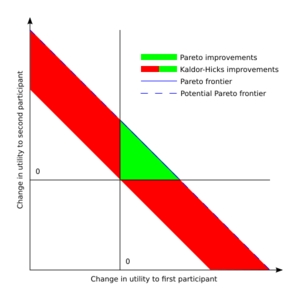Kaldor-Hicks efficiency facts for kids
Kaldor–Hicks efficiency, also called the Kaldor–Hicks criterion, is a way to measure how good an economic situation is. It's named after two economists, Nicholas Kaldor and John Richard Hicks. This idea is a bit like Pareto efficiency, but it's easier to use in real life.
Kaldor–Hicks efficiency helps us decide if a change in the economy is a good idea. Imagine a change happens where some people benefit a lot, and others lose out. If the people who benefit could pay enough money to the people who lose out, so that everyone ends up at least as well off as before, then the change is considered Kaldor–Hicks efficient. This doesn't mean they *actually* pay, just that they *could* pay.
Contents
What is Kaldor–Hicks Efficiency?
Kaldor–Hicks efficiency is a concept used in economics to understand if a change makes society better off overall. It looks at situations where some people gain and some people lose from a decision. The main idea is about whether the winners could, in theory, make up for the losses of the losers.
Understanding the Main Idea
Think of it like this: A new road is built. People who live near the road might have more noise and traffic. But people who use the road save time and money. If the time and money saved by the road users are worth more than the problems caused to those living nearby, then the road project could be Kaldor–Hicks efficient. The winners (road users) could theoretically pay the losers (nearby residents) enough to make them happy.
How it Compares to Pareto Efficiency
You might have heard of Pareto efficiency. With Pareto efficiency, a change is only good if at least one person is better off and no one is worse off. This is a very strict rule. It's hard to find many real-world changes that meet this rule.
Kaldor–Hicks efficiency is less strict. It allows some people to be worse off, as long as the total gains are bigger than the total losses. This makes it much more useful for governments and businesses when making decisions that affect many people. It helps them decide if a project or policy creates enough overall benefit, even if it causes some harm.
Why is it Useful?
Kaldor–Hicks efficiency is important because it helps economists and policymakers evaluate projects. It allows them to consider the total benefits and costs of a decision.
Real-World Decisions
Governments often use ideas like Kaldor–Hicks efficiency when deciding on big projects. For example, building a new airport might help many travelers and businesses. But it could also create noise for people living nearby. Kaldor–Hicks efficiency suggests that if the benefits to travelers and businesses are much larger than the problems for residents, the project could be seen as efficient. This is true even if the residents are not actually paid for their inconvenience.
Thinking About Compensation
The key part of Kaldor–Hicks efficiency is the idea of "potential compensation." It's not about whether compensation actually happens. It's about whether it's possible for the winners to compensate the losers. This means that a project can be seen as efficient even if some people are made worse off, as long as the overall economic pie gets bigger.
See also
 In Spanish: Eficiencia de Kaldor e Hicks para niños
In Spanish: Eficiencia de Kaldor e Hicks para niños


